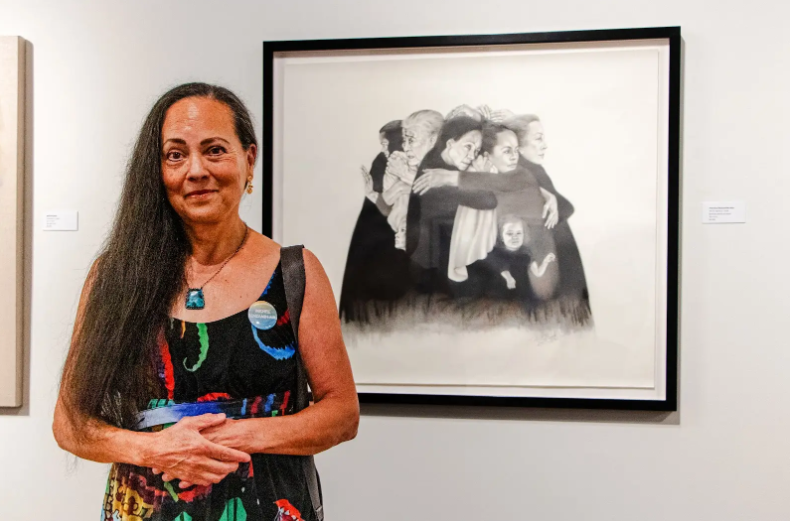A dozen bedazzled ceramic eggs, a 5-foot painting of a ram with war planes in the background and a human-sized handmade patchwork dog plush hung on display at the Irvine Fine Arts Center for the 41st Irvine Annual exhibition’s opening reception on Saturday, July 12.
The Irvine Annual is a juried art exhibit consisting of curator-selected artworks from over 70 artists with work in a variety of mediums, according to the Irvine Annual website.
The pieces were selected by three guest jurors who are local artists and up-and-coming curators, according to the center’s Exhibitions Program Coordinator, Virginia Arce.
Arce has worked for the city of Irvine as the center’s program coordinator since 2019 after graduating from the University of California, Irvine in 2017 with a master’s degree in critical and curatorial studies.
Featuring works selected from an open call for submissions — including local, national and international applicants — the exhibit will remain in the Irvine Fine Arts Center until Aug. 30.
“I thought it was great that [the judges] were both artists and curators,” Arce told New University. “Even though there is no theme, I feel like the jurors selected pieces that all worked together to create a cohesive message.”
A mix of paintings, photography, mixed media portraits and sculptures decorated the plaster walls of the center. Bright studio lighting brought out every fine detail and brush stroke of the exhibited art.
“There’s a lot of representational work, portrait work and non-traditional mediums,” Arce said.
The Irvine Annual, formerly called All Media, was renamed after its 40th anniversary last year as part of an effort to expand the type of art submitted for the exhibit, according to Arce.
“Coming into a new decade, we wanted to try something new,” Arce said.
The center aims to showcase performance art and give artists an opportunity to learn about implementing their own professional practices in art. In turn, the center will host a professional practices panel on Aug. 2.
Guest jurors will lead the panel and have a discussion about what it takes to run an art practice, whether it be an art gallery or studio. Artists will learn about non-traditional lines of work that they may not have considered before.
Angel Lesnikowski, an up-and–coming artist based in Fresno, Calif., had her painting “Grief for the Dispossessed” showcased in the exhibit. With a large, imposing black ram taking up a third of the canvas, Lesnikowski’s five-by-four-foot piece was one of the first paintings people flocked to once the reception began.


Lesnikowski shared that the piece is part of a 14-piece series entitled “Mourning” that explores her greatest fears: death, war and the erosion of women’s rights. In her piece “Grief for the Dispossessed,” her fear of death is personified through the black ram. Its curling horns draw a parallel to the scythe often associated with the grim reaper, another well-known symbol of death.
“I think it came from the way my mom raised me,” Lesnikowski told New University when addressing her deepheld fear of death.
Lesnikowski’s mom and grandmother were Iraqi refugees, and warned her to never go to the country her family came from in fear that she would risk being abducted and exploited as a woman.
Lesnikowski began questioning that depiction of the country in recent years as she befriended people with more direct ties to Iraq and other Arab countries. These friends, Lesnikowski said, helped her understand that visiting her mother’s home country wouldn’t be the death wish that her family claimed it could be.
Still, Lesnikowski acknowledged that her mother and grandmother’s fears may have come from a time when that was the reality of returning home.
“I don’t know if it was fearmongering, or if it was from her experience,” Lesnikowski said.
The exhibit displayed artwork from a range of time frames, including one piece created in 2020, in the midst of COVID-19 lockdowns and temporary restrictions.
“All the Mothers,” a pencil on paper drawing by Michele Benzamin-Miki, depicted a group of women huddled together, some holding babies and others accompanied by young girls.
“I really wanted to focus on my ancestors and my family, particularly the mothers,” Benzamin-Miki told New University.
Benzamin-Miki explained that she had a very deep desire to reconnect with her family history during the pandemic, especially after losing her mother and grandmother within three years of each other. The loss made her contemplate the nature of her relationship with the maternal figures in her life, and pay tribute to them.
Those interested in viewing the pieces mentioned above and other artworks can visit the Irvine Fine Arts Center on 14321 Yale Avenue until Aug. 30, when the exhibition will be closing its doors for the year.
Cain Carbajal is a Features Intern for the summer 2025 quarter. He can be reached at cainac@uci.edu.
Edited by Alyssa Villagonzalo and Annabelle Aguirre

